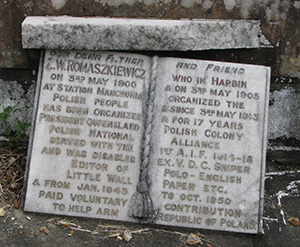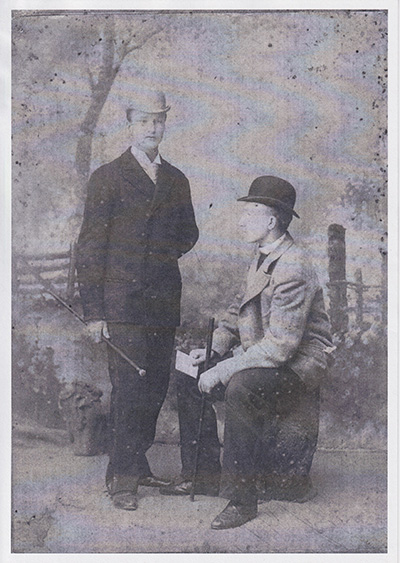Sigismund Vitold Romashkevisch
| Alias | Romasz-Kevisch, Romashkevisch, Romaszkevisch, Romaszkiewicz; Zygmunt Witold |
|---|---|
| Russian spelling | Сигизмунд Витольд Ромашкевич (Сигизмунд Шимонович Ромашкевич) |
| Born | 8.02.1876 |
| Place | Krekinov, Kaunas, Lithuania |
| Ethnic origin | Polish (knew Polish, Russian and Lithuanian languages) |
| Religion | Roman Catholic |
| Father | Shimon Macely Romashkevich |
| Mother | Natalia Bolecka |
| Family | Wife Emily Romashkevisch (nee Stankiewicz) d.1945, children: Witold Boleslaw (Victor Roma) b. 1906, Leonard Ignatius (1910-1960), Arthur (1912-11913), Lidia (b.1915), Gertrude Pelagia |
| Contacts | [Andrew Snegovoy](../Snegovoy), [Victor Schepenski](../Schepenski), [Sigismund Vitold Romashkevich](../Romashkevisch) and [Michael Rowinski (Ravensby)](../Ravensby) arrived at Australia together |
| Residence before arrival at Australia | 'in Harbin on 3rd May 1900 and on 3rd May 1905 at station Manchuria organized the Polish people' (inscription on the monument) |
| Arrived at Australia |
from Nagasaki, Japan on 3.04.1910 per Kumano Maru disembarked at Brisbane |
| Residence before enlistment | Wallumbilla, Barakula, Morningside, Qld |
| Occupation | 1915 saddler & bag maker; 1928 leather goods worker; 1941 waterside worker |
| Naturalisation | 1912 |
| Residence after the war | Morningside, Qld |
| Died | 17.08.1949 |
Service #1
| Service number | 14489 |
|---|---|
| Enlisted | 21.10.1915 |
| Place of enlistment | Brisbane |
| Unit | 15th Field Company Engineers |
| Rank | Driver, Sapper |
| Place | Western Front, 1917 |
| Casualties | WIA 1917 |
| Final fate | RTA 31.07.1918 |
| Discharged | 15.11.1918 MU |
Materials
Digitised naturalisation of Emily Romashkervisch (NAA)
Digitised service records (NAA) (ROMASH-KEVISCH)
Digitised Embarkation roll entry (AWM)
Transfer of Romash Kevisch to Flying Corps (NAA)
Request for assistance - S.V. ROMASHKEVISCH (digitised file) (NAA)
ROMASHKEVISCH Vitold Boleslaw - born 14 July 1906 - Polish (NAA)
Application for admission relatives and friends (digitised file) (NAA)
Digitised naturalisation of LI Romashkevisch 1 2 (NAA)
Romaszkiewicz, Sigismund Vitold - Queensland Internee (NAA)
Lynagh, Gertrude Pelagia [formerly Marsh; nee Romashkevisch] (NAA)
Birth certificate kindly provided by Virginija Chomentauskaite
Blog articles
Newspaper articles (selection)
Recruiting. - Sydney Morning Herald, 22 May 1916, p. 10.
Russian home attacked. - The Ballarat Courier, 19 June 1916, p. 4.
Poles at variance. - The Brisbane Courier, 15 January 1931, p. 14.
Poles charge each other. - Truth, Brisbane, 25 January 1931, p. 15.
The Polish corridor. - The Telegraph, Brisbane, 23 March 1934, p. 8.
E. Jakobowski. Z. Romaszkiewicz jakin go znalem. - Tygodnik Katolicki, Melbourne, 4.09.1954, p. 1.
From Russian Anzacs in Australian History:
Sigismund Vitold Romashkevisch was another with this dual Russian-Polish background: in Australia his surname was spelled both ways, Russian and Polish -- Romashkevisch and Romaszkiewicz -- and he actively involved himself in both communities. A bag-maker from Kovno (now Kaunas, Lithuania), he also knew Lithuanian. Before the war he was not only involved with the Russian Association, writing in Russian for its newspapers, but was also one of the founders in 1913 of 'Ognisko Polskie', the first Polish Association. He was also president of the Polish Society for over 45 years and his gravestone describes him as having 'organised the Polish people'.
[...] One more regiment formed on ethnic principles had a Russian-Australian connection, too -- the Polish army in France. This was formed in 1917 mostly of American and Canadian Polish volunteers whose aim was to establish a free Poland after an Allied victory in the war. I have not found any cases of Russian-born Poles in the AIF applying for transfer into this army, although Sigismund Romashkevisch provided some interesting facts about an attempt to recruit volunteers for this force in Australia. Romashkevisch was recuperating at Weymouth Depot in early 1918, after being wounded at Ypres, when he 'received an invitation ... from the Representant of Polish National Committee in England - Count W. Sobanski and Represe[ntative] of Polish Military Mission Lieut. J.H. De-Rosen to come to London for a personal discussion and arrangements about recruiting by [him] the Poles in Australia and New Zealand for the Polish Army in France'. On his return to Australia in October 1918 he recruited 44 men but had to dismiss them, 'as the war was over before [he] could send them to the Polish Army in France or to Poland'.
[...] Sigismund Romashkevisch's story is another illustration of this fear of being branded a bolshevik. Romashkevisch returned, physically and mentally devastated, from the Western Front to his wife and three children. His wounds prevented him from continuing with his previous work as a saddler and the family could barely make ends meet living on his pension. He applied for help from the Repatriation Department, which was supposed to provide wounded solders with either financial support or work which they could do. Romashkevisch was obviously the type of Russian who never gave up the struggle for justice. His Repatriation Department file is 'a record of voluminous correspondence', and the most striking thing it reveals is his obsession to prove to the bureaucrats that he is not bolshevik, and not even Russian. To combat any possible suspicion on the part of the officials, he wrote: 'It seems to me that this treatment and slownes with it is only because I am not of English origin or even m[a]y be suspected to be a bolshevick, which (if am realy so suspected) is more dreadfull to me as I can tell. ... I am an most loyal man.' In another letter he wrote that he had experienced 'being suspected to be a "Bolshevick"' and that he was 'dredfuly afriten [frightened] of such suspiciousness'. He even attached a 'certificate from the Polish National Committee in which is stated that I am of Polish origin'.
Gallery

Sigismund Romaszkiewicz's Memorial at Balmoral Cemetery

 Russian Anzacs
Russian Anzacs